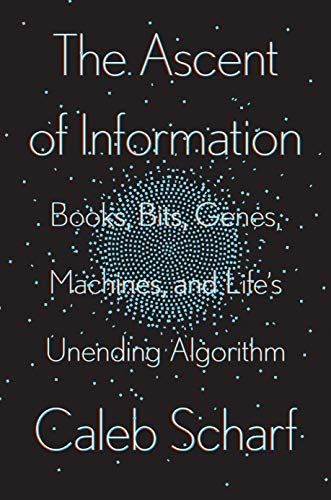Caleb Scharf, director of the Columbia Astrobiology Center, offers a self-renewing, self-contradictory discussion of information as an evolutionary source of universal energy.

Information as Energy
Caleb Scharf, director of the Columbia Astrobiology Center, describes the entirety of human knowledge as the “dataome,” a living, evolving entity of almost infinite power that may shape life and the universe in ways people seldom consider. With breathtaking scope, Scharf explores human history and cognition to define the dataome.
The Dataome
The dataome is a human creation that shapes humanity.
Humans are the only species on Earth that retains information externally, and have been since early humans made marks on cave walls.
What if human cognition didn’t take place only in the mind but also formed the sum total of everything that happens inside and outside the mind, over millions of years, from the smallest atoms and molecules to the cosmos, Scharf enquires? What role does natural selection play in what information proves resilient? If information is substance – not simply an abstract concept – and part of nature’s laws, how people consider the essence of life faces a shocking, necessary revision.
At its core, the dataome is not just about what we get from our data, it is about what our data gets from us.Caleb Scharf
Data and information are not interchangeable, the author notes – data are the components and information is the meaning. Data exists in biological structures, such as the brain, and in silicon chips – both hold information. This information may be a “fundamental currency of the universe” that transcends biology, chemistry and even physics.
This currency simultaneously creates information and creates the rules for how humans utilize it. The dataome records its own history and transformation. Data can be lost, rediscovered and reinterpreted, such as Sumerian cuneiform script, which endured for 3,000 years, then vanished.
17 Trillion Watts
The dataome is costly as it creates and stores data, and especially costly when processing data into meaningful information. Scharf explains that a single component of this data-rich environment has a 630 to 1 ratio production mass – creating it requires 630 times the mass of the finished information in fossil fuels and raw materials. Automobiles, by contrast, have a 2 to 1 ratio.
The data we maintain outside of our biological selves seems to provide us with a massive evolutionary advantage.Caleb Scharf
The dataome has been growing exponentially for centuries, from 100 billion watts in the early 1800s to 17 trillion watts by 2000. Data centers consume about 47 billion watts of energy; the dataome grows by about 40% a year. Data centers will consume all the planet’s energy by 2040.
Human Progress
Change comes at a cost, Scharf posits, especially in how much energy a brain consumes. For example, human brains use about 20% of basal metabolic production while delivering optimal computational ability and efficiency. The dataome changes the brain, helping it adapt to a complex environment while creating that complexity.
Our external information is literally changing our brains, making them better equipped for a complex world and for supporting, in turn, the dataome.Caleb Scharf
The dataome augments memory, organizes complex ideas into graphical representations and maintains archives. It creates art and literature, which spark new ideas and actions. People can reinterpret old data; for example, projects like Zooniverse’s “Old Weather” review old ships’ logs to collect data on ocean temperatures and sea ice coverage to enhance our understanding of today’s climate.
Conversely, China’s Cultural Revolution (1966–1976) destroyed ancient artifacts and halted science, ripping a tear in the dataome and setting China’s progress back by generations.
Information Fuels Evolution
Evolution is a work in progress; both the genome and dataome propagate information.
When we look at life in bulk – as a planet-wide, interrelated phenomenon – what matters most are those recipes or solutions, the ideas for life.Caleb Scharf
They both require a hospitable environment in which to reproduce, and neither cares what information it represents. When gathered, activated and interacting, genes and data contribute to a larger organism – a human-generated or biological entity. The boundary between the biological human mind and the dataome grows increasingly vague.
The Game Itself
Energy drives information flow; information drives energy. If the rules of life’s game emerge from the game itself, then the game’s purpose may be the game itself.
Top-down causation fits with the observation that living systems seem to be able to gain control over the very same matter out of which they are formed.Caleb Scharf
The universe seems to put limits on information and energy. The human brain, for example, is as operational as it needs to be, but no more. The dataome provides assistance, but in evolutionary terms, humans can only hope to keep pace with the game, not master it. The dataome allows humans to change their own matter’s state, and the state of their environment. To continually feed the dataome requires extraordinary energy. This loop, Scharf says, raises the question: What good is limitless knowledge if entropy remains an unstoppable force?
Earth’s Information Processor
The dataome has been millennia in the making, and will soon surpass organic chemistry as the planet’s biggest information processor. Species depletion and climate change portend a mass extinction event that may catapult the dataome into dominance and render biological life obsolete.
Or, Scharf suggests, humans and machines could achieve “endosymbiosis” – evolutionary merging that maximizes human imagination in a non-biological entity. Seen through the dataome lens, human life may merely be a component in an ongoing evolutionary process playing out over billions of years.
Life on Earth is nothing more than a four-billion-year-old catalytic chemical computation. What, you might ask, is it computing? The answer is that it’s computing its own future.Caleb Scharf
The human mind may struggle with being part of the information it seeks to decode. But it causes the universe to possibly rewrite the laws of physics by intersecting with those laws in novel ways. Should this occur, it won’t be a Eureka! moment for humanity because when change engulfs you, as the dataome engulfs humans, you don’t see the change. The game of life perpetually invents the rules by which it plays.
Review
Scharf’s arguments and ideas twist and double back like the DNA helix. He turns his own ideas inside out to inquire – among 100 other inquiries: What is humanity’s fate, considering the ever-expanding scope and power of the dataome? His apparent ease with quantum physics and the ever-present contradictions inherent in the universe’s functioning render Scharf unable or unwilling to provide a single answer, method or even prism through which to view the dataome. His description of its perceptible aspects and potential to alter life on Earth, which only leads to more questions, are as close as you’re going to get to an explanation. Scharf is not in the explanation business. He is in the ever-expansive thinking business. Students, philosophers, the religious, atheists, technocrats and the insatiably curious will revel in Scharf’s elegant arguments.
Caleb Scharf also wrote The Zoomable Universe; The Copernicus Complex; and Gravity’s Engines.






